The Last Meeting Hall Of The Knights Of The Ku Klux Klan?
ArtandSeek.net December 19, 2019 150What may be the last meeting hall built by the Ku Klux Klan in the 1920s still stands in Fort Worth. It’s decrepit, and the current owner wants to demolish it. Art&Seek’s Jerome Weeks reports an arts group hopes to use the hall to up-end its racist origins. But the clock is ticking on that demolition.
The old four-story building is a hulk. It stands just across the Trinity River from downtown Fort Worth. It’s been the North Side’s biggest structure – ever since the Ku Klux Klan built it in 1924. For generations, the North Side has been home to immigrants, African-Americans and Latinos, so the hall’s imposing presence seems designed to intimidate, to stand watch.
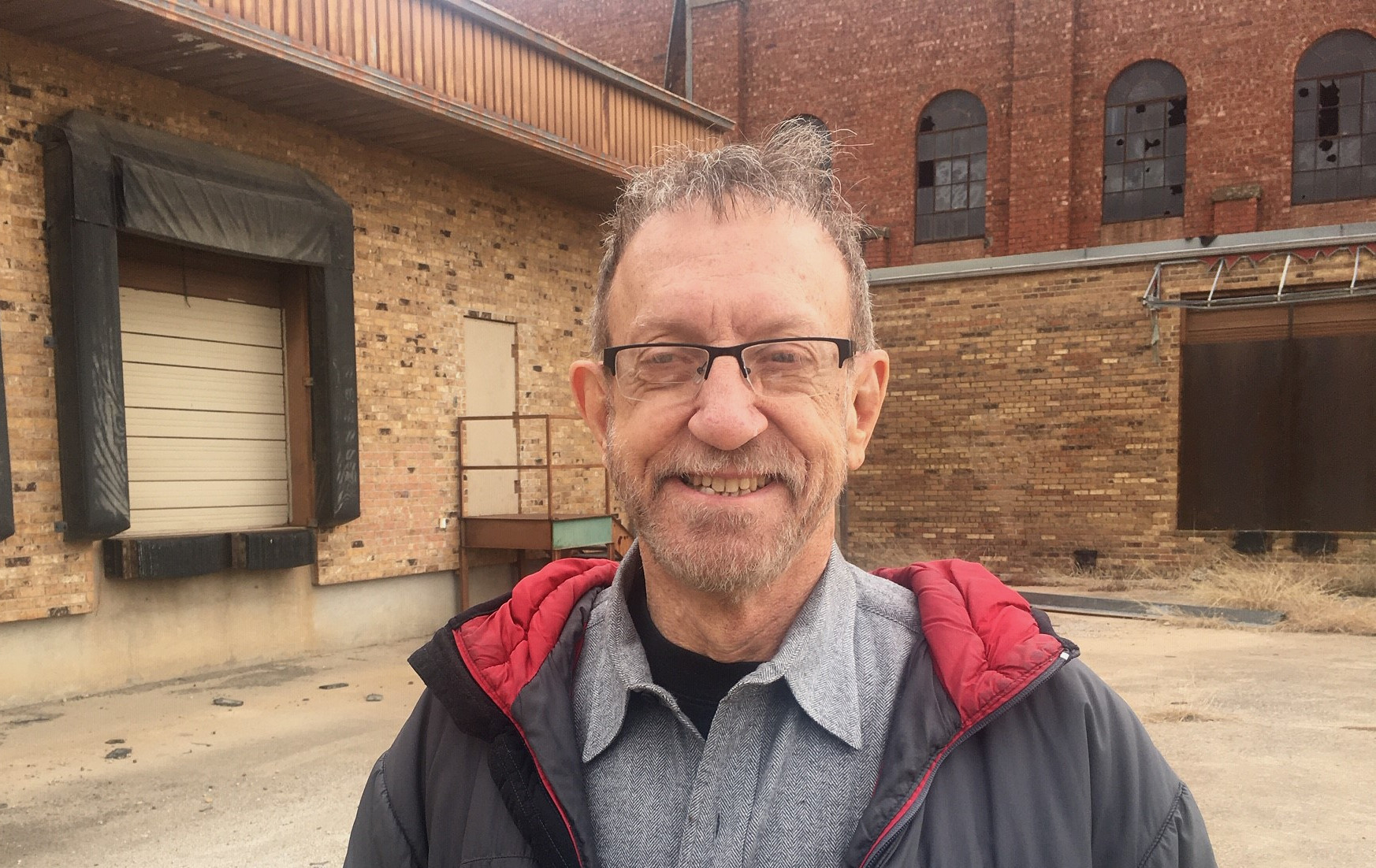
Fort Worth historian Richard Selcer standing on the north side of the hall. Photo: Jerome Weeks
“Most of the old Klan halls,” says Fort Worth historian Richard Selcer, “were little storefronts or they borrowed some meeting place. And this building was built for all of God and humanity to see. And they were very proud of it.”
Selcer stands outside the old hall, which he’s researched. He notes the impressive façade with its tall arched windows like a church. And behind that – it’s just a big, crumbling, red-brick warehouse. This is the kind of industrial construction they did nearly a hundred years ago – but adapted into an auditorium. Selcer estimates it could hold two thousand people.
These days, the hall is splattered with graffiti and broken glass, and the grounds are littered with plastic water bottles left by the homeless people who’ve camped inside. But this squat, grandiose barn was once the public face of Fort Worth Klavern 101 (the numbering started with each state, so Klavern 1 would be the first chapter to form in a state. The high Fort Worth number indicates the extent to which the Klan was established in Texas). The hall was used for business meetings and parades. There were lynchings in Fort Worth — two of them traditionally associated with the Klan — but Selcer says he’s found no evidence that lynchings or even torch-lit rallies were ever held in the hall itself. Instead, it was used for social events, it was rented out. The St. Louis Symphony Orchestra played here.
All this is brick-and-mortar proof that in the 1920s, the Klan was not some isolated bunch of backwoods vigilantes with a rope.
“Nah, nah,” Selcer says, “I mean, to build this, to raise the money by subscription, to put it right up there over the doorway, ‘Ku Klux Klan Hall,’ tells you that they weren’t hiding in the shadows. These people weren’t afraid.”
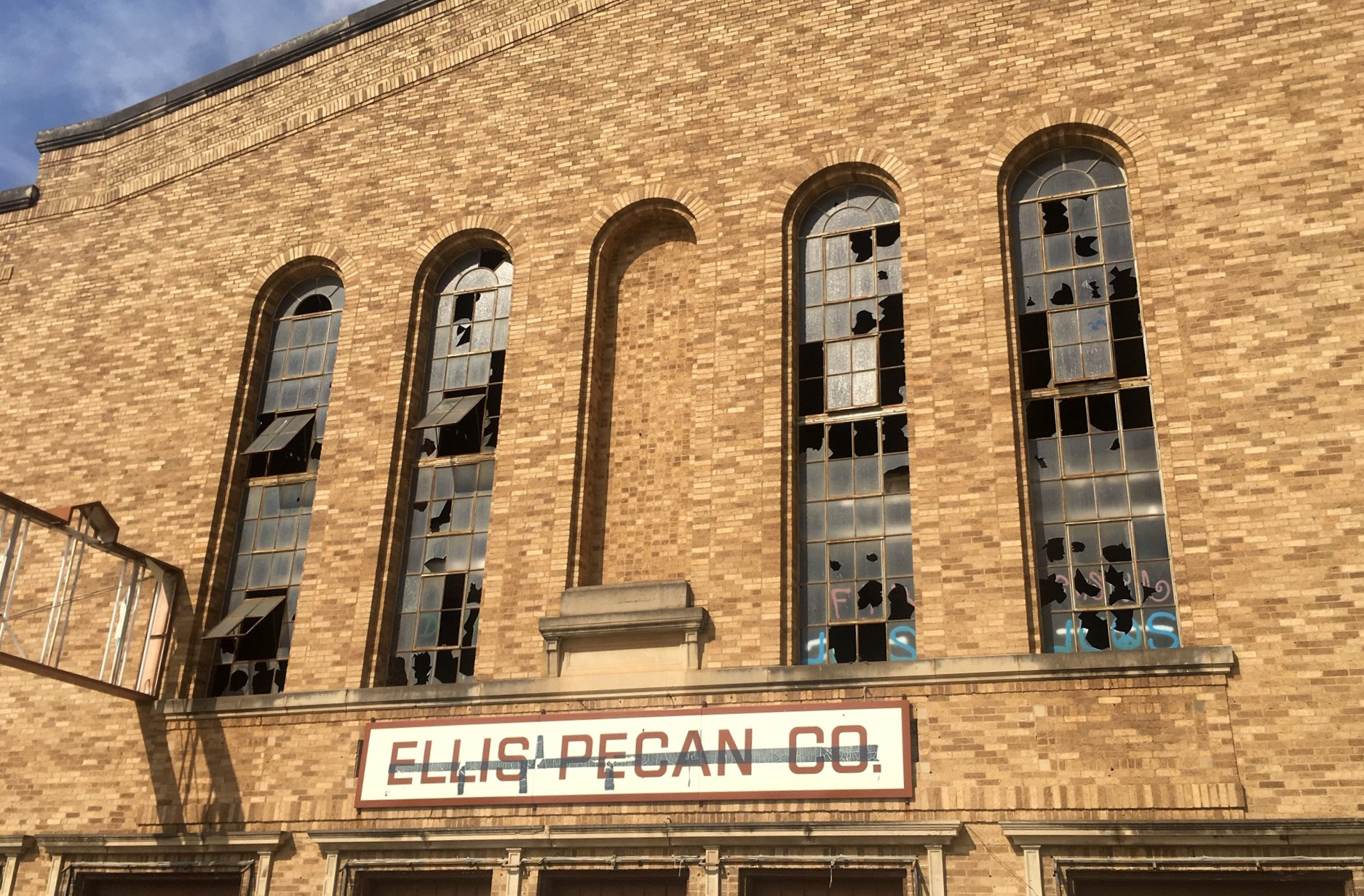
A small niche is visible behind the wooden ‘Ellis Pecan’ sign. The speculation is that the sign masks the original stone-carved name, “Ku Klux Klan Hall.” No one has been able to determine what stood on the pedestal in the tall middle niche (not even the preliminary sketch below indicates anything). Perhaps a flag pole or a cross – because the original Klan hall that stood on this site had both out front. Photo: Jerome Weeks
In fact, this is the second Klan hall to stand here at 1012 North Main. The first burned down in 1924 — whether from arson or an electrical fire is still not known. But the Klan rebuilt immediately. Even the national Klan organization solicited funds from its members for what it said was an $80,000 auditorium ($1.3 million in today’s money — the public figure may have been deliberately inflated in order to raise – and siphon off – more cash). Such a re-building suggests wounded pride, determination, even defiance.
But what once stood tall may soon not be standing at all. In July, the hall’s owner, a limited liability company called Sugarplum Holdings, filed for permission from the city’s Historic and Cultural Landmarks Commission to demolish it.
“The landmarks commission cannot deny the request,” says Murray Miller, Fort Worth’s historic preservation officer. The building was designated “DD” — delay of demolition — it’s the lowest, weakest defense provided by the commission. It simply requires the landowner to notify the city of any plans to bulldoze a structure. What the commission can do then is delay it — for up to 180 days. The delay exists, Miller says, so “the landmarks commission and local preservation groups and other interested parties can explore alternatives to demolition.”
Sugarplum Holdings bought the building in 2004, when it was originally intended to hold the Texas Ballet Theater’s rehearsal hall and classrooms. Nothing came of that plan. In recent years, Sugarplum has been cited by the city for code violations. And the building is in serious disrepair. An overhead look from Google Earth shows the roof has collapsed in different places.
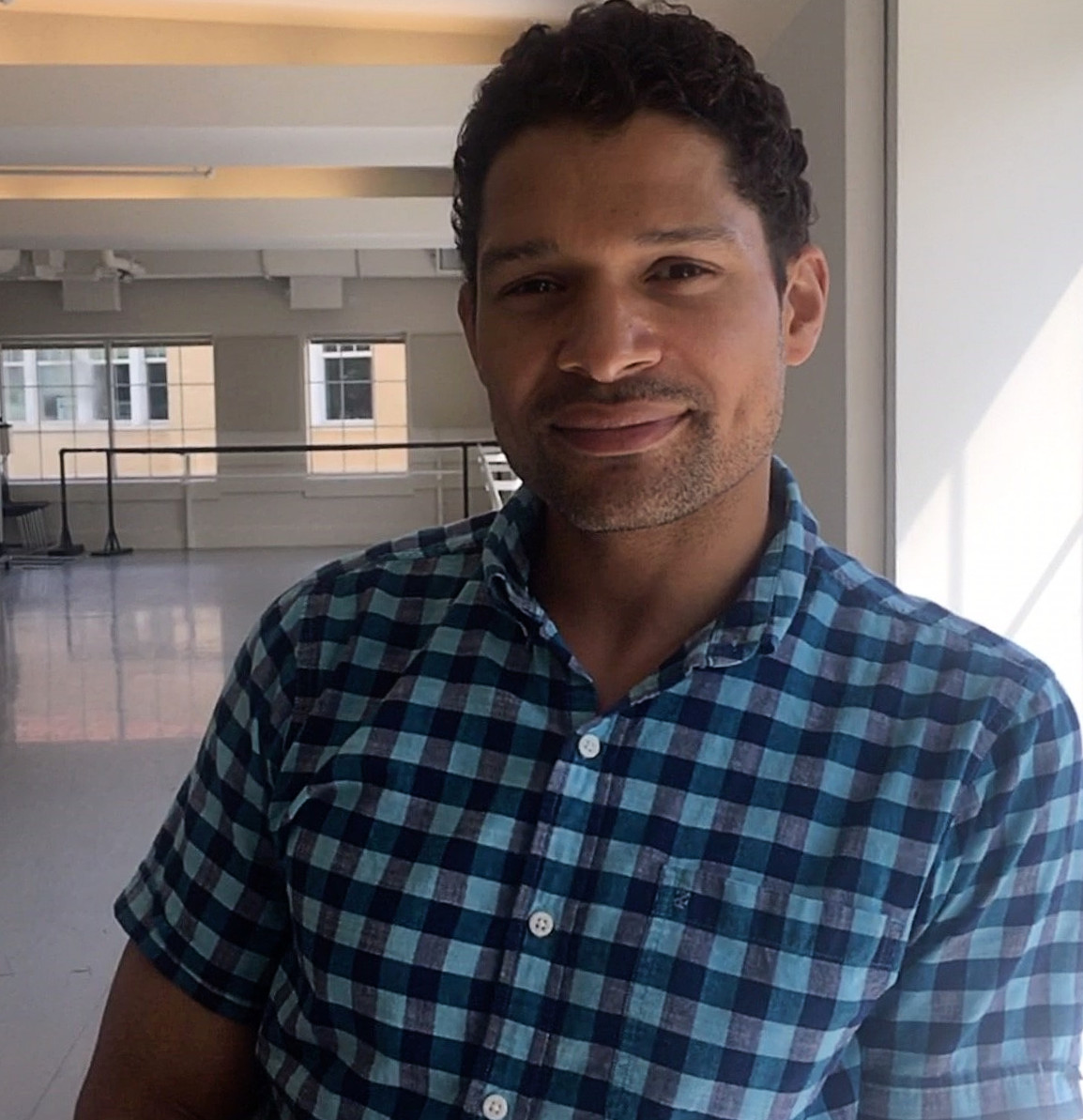
Adam McKinney. Photo: Jerome Weeks
The request for demolition seems to be a cost-benefit response to this situation: It’s cheaper to tear the hall down than to fix it — and cheaper than to keep paying code violations. Another factor: When the Main Street Bridge construction that’s going on directly in front of the Klan hall is finished and the Trinity River bypass canal is dug — all part of the vast Panther Island re-development project — this site will be riverfront property. Prominent riverfront property.
The commission voted for the delay. But it runs out January 4th.
Two of the people working to save the hall are Daniel Banks, who’s white, and Adam McKinney, who’s black. They’re co-directors of a small non-profit called DNAWorks. It uses the arts for healing and social justice.
Preservationists want to restore the hall as a historic artifact. Banks and McKinney have other ideas. They want to use it to counter racial hatred. The hall would become a multi-cultural arts venue, an education center – and more.
“There will be performances,” says McKinney, “there will be exhibits. We have also been talking about a farmer’s market and an artisan’s market, thinking about the ways in which we can support several neighborhoods in Fort Worth, including the North Side.”
McKinney is a dance professor at Texas Christian University, a former member of the Alvin Ailey Dance Company. Banks runs DNAWorks full-time. They’re aware their plans for the “creative re-use” of the Klan hall are ambitious. When the owner’s demolition request was submitted, it included an engineer’s report saying it would cost 8 to 10 million dollars just to bring the hall up to code.
Sugarplum Holdings declined to comment.
But DNAWorks has its own numbers. Says Daniel Banks: “In order to purchase and stabilize the property, based on an asking price that we’ve received from the owner and based on bids that we have gotten, we’re looking at approximately four million dollars.”

Daniel Banks. Photo: courtesy of Daniel Banks
That’s just stabilizing it. The performance center, the farmer’s market: All of those plans, Banks says, push the final cost closer to twenty million.
The numbers don’t faze McKinney. He and Banks have formed a coalition with other arts outfits including the Juneteenth Museum, SOL Ballet Folklórico and the Tarrant County Black Historical and Genealogical Society, all of them representing groups targeted by the Klan. And the duo has been canvassing patrons, philanthropic groups and developers.
“I’m not fearful of what it will cost,” McKinney says. “And in fact, I think it will cost us more by not taking advantage of this moment in time to transform that building into something that will move us together as a community.”
Many Fort Worth residents had no idea their city might have the last-standing, Klan-bought, Klan-built meeting hall in America. That’s partly because the Klan owned it for only two years. It was sold to the Leonard Brothers Department store for storage — and from there, it became a boxing arena and civic auditorium. But for half-a-century, this was the Ellis Pecan Building. The company’s faded sign still hangs out front.
Other residents may not have known about the hall, but city councilmember Dan Flores says, even as a boy, he knew what it stood for. He’s Latino and Catholic, both communities targeted by the Klan. Flores represents District 2, where the hall is located.
“Three generations of my family lived there on the North Side,” says Flores. “A lot of the longtime folks that live on the North Side knew about the building’s past.”
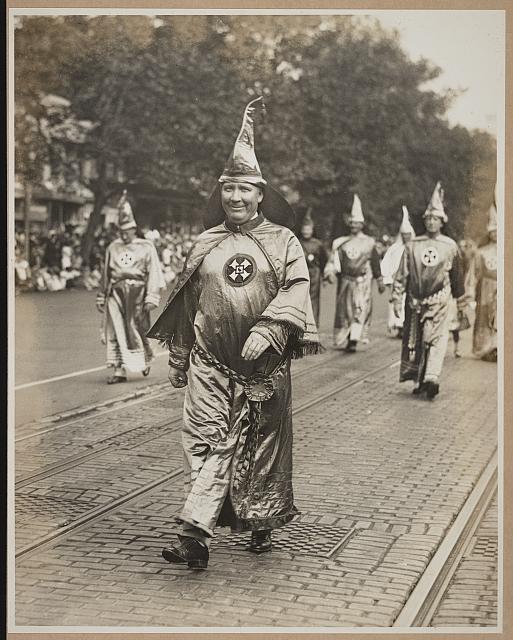
Imperial Wizard H.K. Evans in full regalia leading the KKK march down Pennsylvania Avenue in Washington, D. C., 1924. Photo: Library of Congress
DNAWorks’ plan for ‘creative re-use’ of the hall could benefit the North Side. Flores has publicly supported it with four other city councilmembers – although the council has no say-so on the hall’s ultimate fate.
In 1924, when the hall opened, the Klan had a much more public, even popular presence. And not just in Texas or the South.
“The Klan actually achieved respectability,” says NYU history professor Linda Gordon, who wrote the book, “The Second Coming of the KKK.” She says the original Klan that formed after the Civil War eventually dissolved by World War I because it had essentially succeeded: Jim Crow segregation was locked in place. The 13th, 14th and 15th Amendments to the Constitution were more or less repealed for African-Americans living in the South.
But the 1915 release of director D. W. Griffiths’ epic film, ‘Birth of a Nation’ — so successful, it toured for years — was practically a recruiting drive for the Klan. Griffiths gave them costumes they’d never worn, a unified presence (which they also never had) and, of course, the whole, heroic, mystical-knightly, patriotic, racist sense of a noble past and a grand, pure goal for the future.
But the man who re-invented the Klan, William J. Simmons, actually created it as a money-making, fraternal organization and political machine. The ’20s was the great age of fraternal organizations like the Masons, the Oddfellows, the Knights of Columbus, the Knights of Pythias. The Klan fit right in with the need for many people – in an age when radio was the only worldwide mass medium — to connect with others, to make business connections, social connections. If Catholics had the Knights of Columbus and African-Americans had the Knights of Pythias, why not the Knights of the Klan for white Protestants?
But Simmons also knew how a fraternal organization could be used to make money. Lots of money. As Gordon notes, this second Klan was actually established as a for-profit company — and under Simmons, it became a pyramid scheme, with a sizable portion of new membership dues, fees for Klan regalia, even sales of life insurance, all ending up in his pocket.
But Simmons was small-time compared to the Klan’s subsequent leadership. Under Hiram Evans, a former Dallas dentist, the Klan gained millions of members. By the end of the decade, there were more Klan members in the North than the South. Gordon calls it one of the most meteoric political trajectories in American history – before the Tea Party. The Klan ran the state governments in Oregon and Indiana. The head of the Texas Rangers was a proud Klansman. Ultimately, as a demonstration of the Klan’s popularity and power — and an indication of Evans’ ambitions — he moved the KKK’s headquarters to Washington, D.C.. It was there that thousands of Klan members paraded in 1924 — without their masks, down Pennsylvania Avenue.
“It was a very wealthy organization,” says Gordon. “It owned two radio stations, it operated a hundred and fifty some newspapers. And this is not counting all the money accrued by its very, very corrupt top leadership.”

The south side of the Klan hall. The windows could be opened; they provided the interior with much of its light and ventilation. The tall portion at the far end is above the stage – traditionally, it’s the “fly space” of a theater, where the lights are and where painted backdrops could be raised or “flown.” The other additions – metal doors, the concrete-and-steel stage entrance – were probably added by the Ellis Pecan Company. Photo: Jerome Weeks
But another reason the Klan had such a sudden rise was cultural. It was the Roaring Twenties. Bootleggers, jazz, the rising tide of Catholic and Jewish immigrants from Eastern Europe, black Americans migrating to the cities: All of this frightened many white Americans, North and South, striking them as immoral and destabilizing. And the Klan responded – with terrorism but also with political influence and popular appeals to what it called “100 percent Americanism.” Gordon notes two professions that were prominent among Klan members: law enforcement and Protestant ministers.
As a result, historian Richard Selcer says, Klan members did not simply terrorize minorities. They enforced what they saw as the public good. After all, they were knights, sworn to the highest ideals.
“They’re protectors of morality and patriotism,” he says, “and if that means whipping some wife-beater-drunk, then that’s not racial terrorism, that’s protecting family and motherhood.”
It’s no accident that the fortunes of Fort Worth’s Klan hall can be tied to the rise and fall of the Klan in Texas: The Klan took off soon after Prohibition became law in 1920. KKK membership often overlapped with temperance groups, and Klan members often aided the police in battling bootleggers (with the Klan members, under those robes, often being sheriffs and police officers anyway). The first hall went up in 1921.
By 1924, when the second hall was built in Fort Worth, the Klan tried to take over the governor’s mansion. Hiram Evans backed University of Texas dean George C. Butte against Miriam “Ma” Ferguson. Butte would have been the first Republican governor elected in Texas since Reconstruction. But the Klan lost badly against Ma Ferguson, who ran an overtly anti-Klan campaign. Two years later, the Klan sold the hall to the Leonard Brothers store.
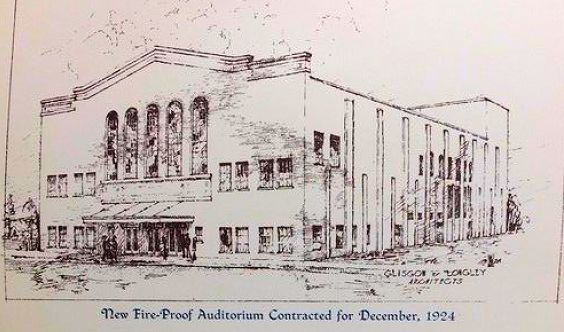
Sketch for the proposed Klan hall. The architect was Klansman Earl Glasgow . He clearly expanded and embellished on the original, notably the facade with its awning, peaked cornice and prominent marquee, plus the ‘fly house’ in back. Image: courtesy Richard Selcer.
By the late ‘30s, the national Klan went bankrupt from multiple scandals about its leadership getting rich. But Gordon says, as with the original Klan, this Klan faded from view partly because it, too, had succeeded: The Johnson-Reed Act of 1924 was the most anti-immigration law in American history. It severely limited the number of Italians, Jews, Greeks, Poles and other Slavs, while some 60 percent of all immigrants came from just Great Britain, Germany and Ireland. The Johnson-Reed Act was the law for 40 years — until Lyndon Johnson signed the Immigration and Nationality Act of 1965. Rep. Albert Johnson, who co-sponsored the Johnson-Reed Act, was a Klansmen.
The Klan really only returned — locally, independently, not as a national organization — when the civil rights era began in the 1950s.
Today, Daniel Banks is encouraged, he says, because the hall’s owner, Sugarplum Holdings, has been open to discussions. January 4th may not be a do-or-die deadline for the demolition. There may be options. But Banks is also realistic: “The clearest path would be to have, say, a commercial real estate developer who had the capital, had the experience in doing this, to make an offer to the owners, and then allow our leadership coalition to be the stewards or be the stewards in some partnership with the developer.”
Fort Worth could certainly use a good, off-campus, mid-size performance hall or exhibition venue — especially for minority cultural groups. Something between Jubilee Theatre and Bass Hall.
But if many American cities, including Fort Worth, are still arguing about removing Confederate monuments, why would anyone want to save this brick embodiment of hatred?
Adam McKinney says, as a black man, he’s aware people may find preserving the Klan hall hurtful. But he stresses, he’s not trying to preserve it. The building has a kind of power, he says, and he wants to use that.
“It’s important to stand in the building,” McKinney says, “to feel the energy in that space. We hope that people will enter the building and leave changed.”

This was the first Klan hall to stand at 1012 N. Main Street in Fort Worth. It was built in 1921, burned down in 1924. Note the generally similar structure. Also, on the right, the flagpole and cross combo.
There are examples of cities taking their violent, embarrassing history and transforming it into a powerful, cultural and political statement: The Lorraine Motel in Memphis, where the Rev. Martin Luther King, Jr., was assassinated, has been turned into the National Civil Rights Museum. The Sixth Floor Museum in Dallas now draws a half-million visitors a year to the site of President Kennedy’s assassination — which was once a mark of shame for the city. Of course, it took Dallas 23 years to do it, to work through all the arguments and claims and conflicting visions.
Historian Richard Selcer agrees about the need to stand in the hall to understand what’s at stake, to feel the history, as dark as it may be. He gives tours of historic Fort Worth — and often finds himself extolling the significance of a building that’s now a gas station.
Instead of that, he says, imagine bringing schoolkids into the Klan hall. To stand where the Klan once stood, to see what the Klan once built — and what it’s now become.
If a picture’s worth a thousand words, Selcer asks, what’s a building worth?
[FYI: A small local note: The title of this story plays on a one-act written by Dallas playwright Preston Jones in 1962. It’s the opener in his famed “Texas Trilogy”: “The Last Meeting of the Knights of the White Magnolia.” It’s a “tragicomedy” set in a small West Texas town with a depleted, aging splinter group of the Klan.]










